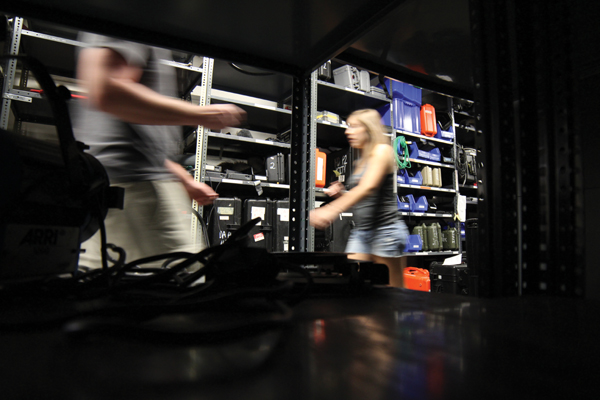

Lights, camera, action! That is, if you reserve a camera before Thursday.
The School of Communication equipment room houses everything from HD cameras to extension cords and is the one-stop shop for SoC students who need equipment to complete assignment and final projects.
The cost of the equipment runs anywhere from several hundred to several thousand dollars, which means that not many students can afford to purchase their own equipment.
However, for some students, getting equipment can be a challenge. With final project due dates looming, the equipment room’s shelves are nearly empty on by the end of the week.
“We find that the shelves are empty on Thursdays and Fridays,” said Tod Landess, the production equipment supervisor. “This is the crunch now.”
Equipment is allocated to students on a first-come, first serve basis. Students can reserve equipment online or visit the equipment room, located in room 1014 in the Wolfson Building.
Visual journalism classes especially struggle to get required cameras. Three introductory visual journalism classes, which have up to 16 students each, must share 21 Cannon Rebel XT cameras. Additionally, there are only five Cannon T3i cameras available for the 14 students enrolled in the video journalism class.
Film students have 38 HMC 150 cameras to choose from but visual journalism students also often request these cameras.
Missing and broken equipment poses yet another problem. Junior Hadley Jordan, a visual journalism major, had trouble getting batteries to operate a camera.
“I went in there on Thursday and I checked out a camera. They said, ‘We don’t have any batteries for you,’” she said. “In visual journalism, the news happens when it happens. I had to leave my job early to get another battery.”
Equipment that is broken cannot be rented out to students, which reduces the amount of equipment available to students.
“Inventory can show we have more available then we do because we may have a new round of broken stuff,” said Tod Landess, the production equipment supervisor. “The common issues are wireless mics that get damaged because students close them in the case or tripods that get damaged.”
However, the SoC is making strides in acquiring more equipment for rental. Each year, the school allocates a certain percentage of its budget to cover the expenses of new equipment.
“We’ve been adding new equipment on a consistent basis,” said Tom Ortiz, the director of technical operations and engineering for the School of Communication. “Last budget cycle, I was able to add 20 new HD (high definition) cameras to our fleet.”
For the past three years, the equipment room has been in the process of transitioning to high definition cameras for all disciplines, since this is the direction the communications industry is headed in.
“We’re in the transition of going from acquiring on tape to acquiring on an SD card,” Landess said. “We’re working on one main fleet. Eventually it will be over 40 [cameras].”
Broadcast journalism students have not seen this transition due to the studios they currently use. According to Ortiz, the studios only use tape and broadcast students would not be able to use any HD equipment even if the SoC purchased it.
Some, like senior Ryan Aquilina, a motions pictures major, have purchased their own cameras to keep up with the industry.
“DSLRs are becoming very popular to film with right now,” he said. “You see a lot of students buying their own cameras. I have 4 film friends that have their own cameras.”
Still, Aquilina acknowledges that it is simply not feasible for students to purchase all the equipment they need.
“I still have to go in for sound equipment, for a tri-pod, for lighting,” he said. “That’s something that not all of us can invest in. Tripods can be several hundred dollars.”





